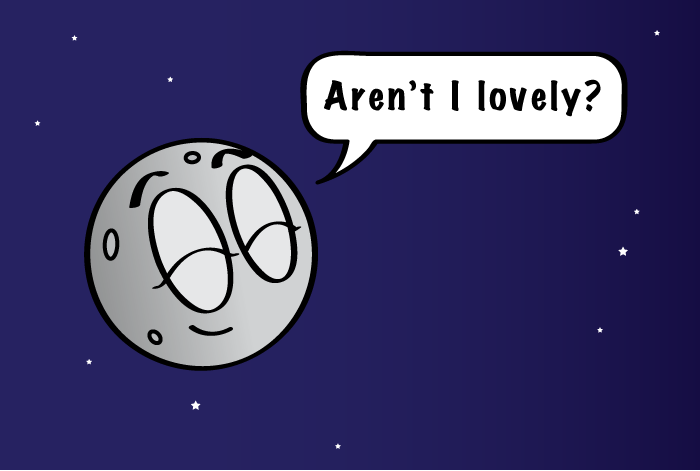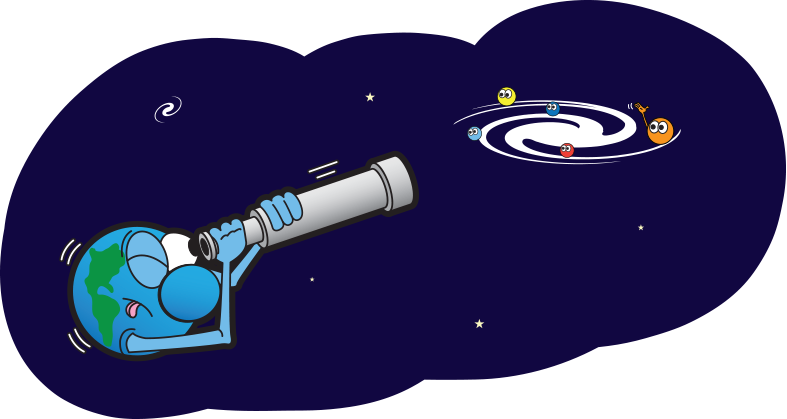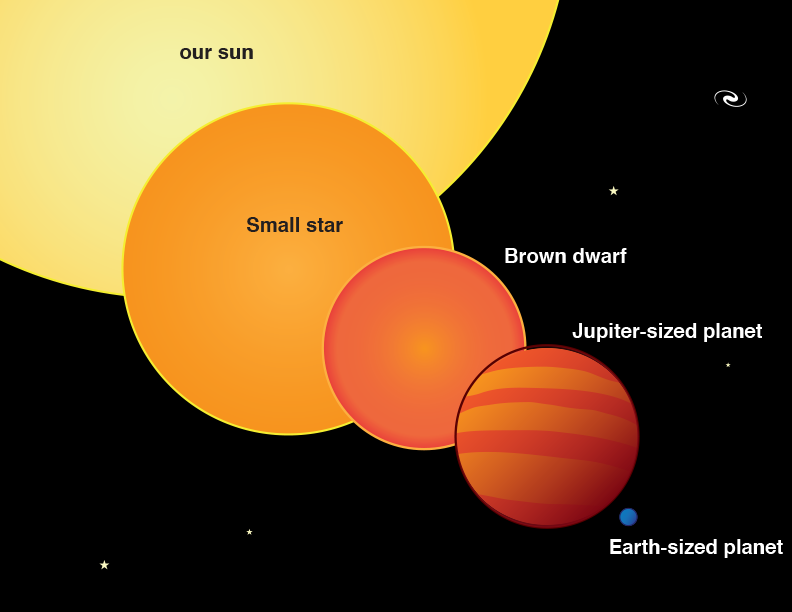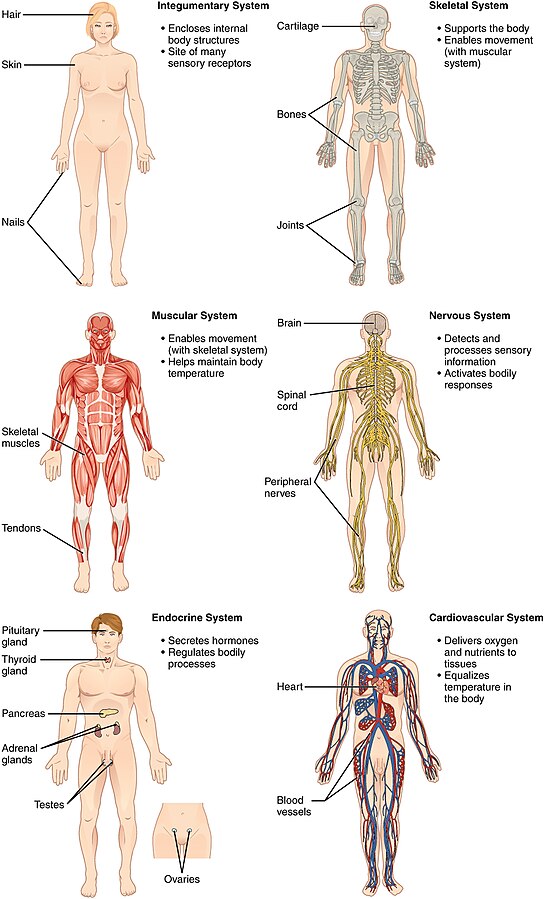At maturity, the estimated average number of cells in the body is given as 37.2
trillion. This number is stated to be of partial data and to be used as a starting point for further calculations. The number given is arrived at by totalling the cell numbers of all the
organs of the body and cell types.
[2] The
composition of the human body is made up of a number of certain
elementsincluding
carbon,
calcium and
phosphorus.
The study of the human body involves
anatomy and
physiology. The human body can show anatomical non-pathological anomalies known as variations which need to be able to be recognised. Physiology focuses on the systems and their organs of the human body and their functions. Many systems and mechanisms interact in order to maintain
homeostasis.
Structure[edit]
Many other smaller cavities exist throughout the body called
sinuses, which have varied functions.
Sinuses in general usage refers to the
paranasal sinuses which are involved in the condition
sinusitis. The paranasal sinuses are four pairs of vital air-cavities in the
cranial bones. These
air-filled spaces are paired between the eyes, above the eyes, deeper behind the eyes and around the
nasal cavity.
Composition[edit]

The main elements that compose the human body are shown from most abundant, by mass, to least abundant.
The average adult body contains between 5 and 5½ litres of blood and approximately 10 litres of
interstitial fluid.
The composition of the human body can be referred to in terms of its water content, elements content, tissue types or material types. The adult human body contains approximately 60%
water, and so makes up a significant proportion of the body, both in terms of weight and volume. Water content can vary from a high 75% in a newborn infant to a lower 45% in an
obese person. (These figures are necessarily
statistical averages).
Human anatomy[edit]

Anatomical study by Leonardo da Vinci
Human anatomy (gr. ἀνατομία, "dissection", from ἀνά, "up", and τέμνειν, "cut") is primarily the scientific study of the
morphology of the human body.
[3]Anatomy is subdivided into
gross anatomy and microscopic anatomy (
histology)
[3] Gross anatomy (also called topographical anatomy, regional anatomy, or anthropotomy) is the study of anatomical structures that can be seen by the naked eye.
[3] Microscopic anatomy involves the use of
microscopes to study minute anatomical structures, and is the field of histology which studies the organization of tissues at all levels, from
cell biology(previously called cytology), to organs.
[3] Anatomy,
human physiology (the study of function), and
biochemistry (the study of the chemistry of living structures) are complementary basic medical sciences,
[4] that are generally taught together (or in tandem) to students studying
medicine.
Generally,
physicians,
dentists,
physiotherapists,
nurses,
paramedics,
radiographers, and students of certain
biological sciences, learn gross anatomy and microscopic anatomy from anatomical models, skeletons, textbooks, diagrams, photographs, lectures, and tutorials. The study of microscopic anatomy (or
histology) can be aided by practical experience in examining histological preparations (or slides) under a
microscope; and in addition, medical and dental students generally also learn anatomy with practical experience of
dissection and inspection of cadavers (corpses). A thorough working knowledge of anatomy is required for all
medical doctors, especially
surgeons, and doctors working in some diagnostic specialities, such as
histopathology and
radiology.
Human anatomy,
physiology, and
biochemistry are basic medical sciences, generally taught to medical students in their first year at medical school. Human anatomy can be taught regionally or systemically;
[3] that is, respectively, studying anatomy by bodily regions such as the head and chest, or studying by specific systems, such as the nervous or respiratory systems. The major anatomy textbook,
Gray's Anatomy, has recently been reorganized from a systems format to a regional format, in line with modern teaching.
[5][6]
Anatomical variations[edit]
In human
anatomy, the term
anatomical variation refers to a non-pathologic anatomic structure that is different from normal. The possible anatomic variations in each organ and its arterial and venous supply must be known by physicians, such as
surgeons or
radiologists, in order to identify them. Unlike
congenital anomalies, anatomic variations are typically inconsequential and do not constitute a disorder.
Accessory muscles are rare anatomical duplicates of muscle that can occur and only require treatment where function is impaired. The
accessory soleus muscle in the ankle is one such variation and one which does not need to be rectified.
[7][8] Another more common variation found in around ten per cent of the population is the
accessory spleen.
[9]
Human physiology[edit]
Human physiology is the science of the mechanical, physical,
bioelectrical, and
biochemical functions of humans in good
health, their
organs, and the
cells of which they are composed.
Physiology focuses principally at the level of organs and
systems. Most aspects of human physiology are closely
homologous to corresponding aspects of
animalphysiology, and
animal experimentation has provided much of the foundation of physiological knowledge.
Anatomy and physiology are closely related fields of study: anatomy, the study of form, and physiology, the study of function, are intrinsically related and are studied in tandem as part of a
medical curriculum.
Systems[edit]
The human body consists of many interacting systems. Each system contributes to the maintenance of homeostasis, of itself, other systems, and the entire body. A system consists of two or more
organs, which are functional collections of tissue. Systems do not work in isolation, and the well-being of the person depends upon the well-being of all the interacting body systems. Some combining systems are referred to by their joint names such as the nervous system and the endocrine system known together as the
neuroendocrine system.
| System | Clinical study | Physiology |
 | The nervous system consists of the central nervous system (the brain and spinal cord) and theperipheral nervous system. The brain is the organ of thought, emotion, memory, and sensory processing, and serves many aspects of communication and controls various systems and functions. The special senses consist of vision, hearing, taste, and smell. The eyes, ears, tongue, and nosegather information about the body's environment. | neuroscience, neurology(disease), psychiatry(behavioral),ophthalmology (vision),otolaryngology (hearing, taste, smell) | neurophysiology |
 | The musculoskeletal system consists of the human skeleton (which includes bones, ligaments,tendons, and cartilage) and attached muscles. It gives the body basic structure and the ability for movement. In addition to their structural role, the larger bones in the body contain bone marrow, the site of production of blood cells. Also, all bones are major storage sites for calcium and phosphate. This system can be split up into the muscular system and the skeletal system. | orthopedics (bone and muscle disorders and injuries) | cell physiology, musculoskeletal physiology, osteology (skeleton), arthrology (articular system), myology (muscular system)[10] |
 | The circulatory system or cardiovascular system comprises the heart and blood vessels (arteries,veins, and capillaries). The heart propels the circulation of the blood, which serves as a "transportation system" to transfer oxygen, fuel, nutrients, waste products, immune cells, and signalling molecules (i.e.,hormones) from one part of the body to another. The blood consists of fluid that carries cells in the circulation, including some that move from tissue to blood vessels and back, as well as the spleen andbone marrow. | cardiology (heart),hematology (blood) | cardiovascular physiology[11][12]The heart itself is divided into three layers called theendocardium, myocardium andepicardium, which vary in thickness and function.[13] |
 | The respiratory system consists of the nose, nasopharynx, trachea, and lungs. It brings oxygen from the air and excretes carbon dioxide and water back into the air. | pulmonology | respiratory physiology |
 | The digestive system consists of the mouth including the tongue and teeth, esophagus, stomach, gut(gastrointestinal tract, small and large intestines, and rectum), as well as the liver, pancreas, gallbladder, and salivary glands. It converts food into small, nutritional, non-toxic molecules for distribution by the circulation to all tissues of the body, and excretes the unused residue. | gastroenterology | gastrointestinal physiology |
 | The integumentary system consists of the covering of the body (the skin), including hair and nails as well as other functionally important structures such as the sweat glands and sebaceous glands. The skin provides containment, structure, and protection for other organs, but it also serves as a major sensory interface with the outside world. | dermatology | cell physiology, skin physiology |
 | The urinary system consists of the kidneys, ureters, bladder, and urethra. It removes water from the blood to produce urine, which carries a variety of waste molecules and excess ions and water out of the body. | nephrology (function),urology (structural disease) | renal physiology |
 | The reproductive system consists of the gonads and the internal and external sex organs. The reproductive system produces gametes in each sex, a mechanism for their combination, and a nurturing environment for the first 9 months of development of the infant. | gynecology (women),andrology (men),sexology (behavioral aspects) embryology(developmental aspects), obstetrics(partition) | reproductive physiology |
 | The immune system consists of the white blood cells, the thymus, lymph nodes and lymph channels, which are also part of the lymphatic system. The immune system provides a mechanism for the body to distinguish its own cells and tissues from alien cells and substances and to neutralize or destroy the latter by using specialized proteins such as antibodies, cytokines, and toll-like receptors, among many others. | immunology | immunology |
 | The main function of the lymphatic system is to extract, transport and metabolize lymph, the fluid found in between cells. The lymphatic system is very similar to the circulatory system in terms of both its structure and its most basic function (to carry a body fluid). | oncology, immunology | oncology, immunology |
 | The endocrine system consists of the principal endocrine glands: the pituitary, thyroid, adrenals,pancreas, parathyroids, and gonads, but nearly all organs and tissues produce specific endocrinehormones as well. The endocrine hormones serve as signals from one body system to another regarding an enormous array of conditions, and resulting in variety of changes of function. There is also theexocrine system. | endocrinology | endocrinology |
Homeostasis[edit]
The term
homeostasis refers to a system that regulates its internal environment and maintains a stable, relatively constant condition; such as maintaining an equal temperature, or acid balance
pH. This is required for the body to function properly. Without a relatively constant pH, temperature, blood flow, and position, survival would be impossible.
Many interacting systems and mechanisms act to maintain the human's internal environment. The nervous system receives information from the body and transmits this to the brain via
neurotransmitters. The
endocrine system may release hormones to help regulate blood pressure and volume. Cell
metabolism may help to maintain the blood's pH.
Society and culture[edit]
Depiction[edit]
![[icon]](https://upload.wikimedia.org/wikipedia/commons/thumb/1/1c/Wiki_letter_w_cropped.svg/20px-Wiki_letter_w_cropped.svg.png) | This section requires expansion.(November 2013) |
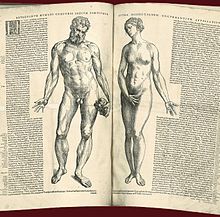
Image of two facing pages of text with woodcuts of naked male and female figures. "Epitome" by
Andreas Vesalius, fol. 10b and 11a. HMD Collection, WZ 240 V575dhZ 1543.
Anatomy has become a key part of the visual arts. Basic concepts of how muscles and bones function and change with movement are vital in drawing, painting or animating a human figure. Many books (such as "Human Anatomy for Artists: The Elements of Form") have been written as guides to drawing the human body anatomically correctly.
[14] Leonardo da Vinci sought to improve his art through a better understanding of human anatomy. In the process he advanced both human anatomy and its representation in art.
Because the structure of living organisms is complex, anatomy is organized by levels, from the smallest components of cells to the largest organs and their relationship to others.
Appearance[edit]
History of anatomy[edit]
The
history of anatomy has been characterized, over a long period of time, by an ongoing, developing understanding of the functions of
organs and structures in the human body. Methods have advanced dramatically, from the simple examination by dissection of
animalsand
cadavers (corpses), to the development and use of the microscope, to the far more technological advances of the electron microscope and other complex techniques developed since the beginning of the 20th century. During the 19th and early 20th centuries it was the most prominent biological field of scientific study.
[15]
History of physiology[edit]
The biological basis of the study of physiology, integration refers to the overlap of many functions of the systems of the human body, as well as its accompanied form. It is achieved through communication that occurs in a variety of ways, both electrical and chemical.
In terms of the human body, the endocrine and nervous systems play major roles in the reception and transmission of signals that integrate function. Homeostasis is a major aspect with regard to the interactions in the body.





